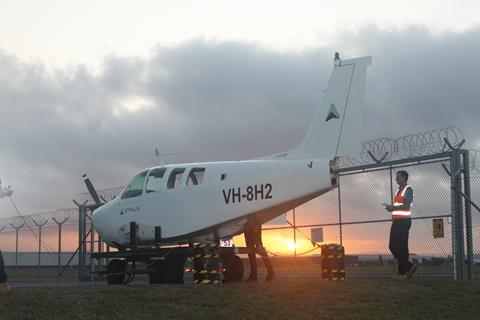In the corner of a hangar on the edge of Brisbane Airport, a wingless Beech Bonanza called Clyde has become a key enabler of zero emission flight.
For decades, this six-seat, piston-powered plane flew for Darwin-based Air Frontier in the nation’s searing Northern Territory.

Now it’s flightlessly pioneering new air frontiers as a ground test rig for Stralis Aircraft, a start-up developing hydrogen-electric powertrains to retrofit existing planes and power future designs.
Stralis is one of a growing number of sustainable aviation enterprises evolving in Australia, a nation which has been slower than many to embrace cleaner flight.
One by one, projects are taking off, among them plans for locally-produced sustainable aviation fuels, battery and hydrogen-electric propulsion systems and aircraft, and proposals for green hydrogen production at or near airports.
All of this is occurring as the Federal Government finalises an Aviation White Paper which it says will guide the sector’s economic and sustainable growth to 2050.
As in most markets transitioning to low-or-no emission flight, SAF is considered the biggest, fastest pathway to meaningful progress, a one-size-fits-all solution until others evolve to sufficient scale.
Near Perth, the capital of Western Australia, BP is well advanced with plans to convert its Kwinana oil refinery to produce SAF and renewable diesel from 2026, using recycled fats, oils and greases as feedstocks.
Across the country, in tropical North Queensland, emerging biofuel refiner Jet Zero Australia and US-based LanzaJet have just announced a Licence and Engineering agreement to progress development of another SAF facility near the coastal city of Townsville.
Designated ‘Project Ulysses’ after a butterfly species in the region, and subject to final investment approval, the new plant should start production late in 2026 or early 2027, says Jet Zero chief executive Ed Mason.
It will have annual capacity to produce 102 million litres, leveraging LanzaJet’s alcohol-to-jet technology, through which ethanol is created from feedstocks including sugar cane, then converted to SAF – a natural diversification for North Queensland, a major sugar producing region.
Other partners are the Queensland State Government, Airbus, and Australia’s largest airline group, Qantas, a long-and-loud campaigner for a local SAF sector, arguing the country has abundant feedstock but no production capacity.
“Sustainable aviation fuel is the most significant tool airlines have to reduce their emissions, but it’s only available offshore with no local supply for airlines in Australia,” says Andrew Parker, Qantas Group’s chief sustainability officer.
Qantas already uses foreign-sourced SAF for some international flights and will buy up to 500 million litres annually from 2028. To support Australian SAF production, it wants enabling policies including mandates for blending and use.
“We think Australia has every chance of becoming a sustainable fuels superpower with the right support from government and industry,” adds Stephen Forshaw, Airbus chief representative, Australia, New Zealand, and Pacific “The challenge to start production is urgent.”
In the southern city of Melbourne, Dovetail Electric Aviation is also progressing sustainable flight, developing battery-electric powertrains to retrofit into current commuter planes.
The first, scheduled to fly early next year, is a Cessna Caravan of tourist airline Sydney Seaplanes, which co-founded Dovetail with Europe’s Dante Aerospace, and has drawn orders and options valued over US$160 million for its zero emission conversion kits.
Next year, says chief executive David Doral, Dovetail plans to switch a Beech King Air to hydrogen-electric propulsion. It will come from Pel-Air, a sibling of Australian domestic airline Rex, whose fleet includes 52 Saab 340 turboprops, the world’s largest fleet of the type.
Rex has also invested in Dovetail and plans to use one of the Saabs as a testbed for zero emission powertrains, potentially converting more since no equivalent-size replacement aircraft exists.
Stralis is also making headway. Co-founder and chief executive Bob Criner, an aerospace engineer, says his company is small, but has big plans for liquid hydrogen powered flight.
Clyde, the test-rig Bonanza, performed its first zero-emission ‘prop-spin’ late last year, and this year its sibling, called Bonnie, is scheduled to perform the company’s first hydrogen-powered flight.
Next year, Stralis plans to convert a Beech 1900D commuter plane, targeting supplemental type certification in the USA and Australia, and entry into service by 2026.
Then in 2028, it plans to start building a clean-sheet 50-seater, currently designated the SA1, aiming for commercial launch by 2030.
So, why Bonnie and Clyde? Two outlaws.
Unintentional association, explains Criner. Bonnie was an Aussie nickname for the first Bonanza and Clyde seemed an obvious choice for the second.
“But Bonnie and Clyde does have a ring to it,” he concedes.
“When we started out, we were told ‘It won’t work. You can’t do that.’ But we are. We feel like we are pushing the boundaries and disrupting the status quo.”





























